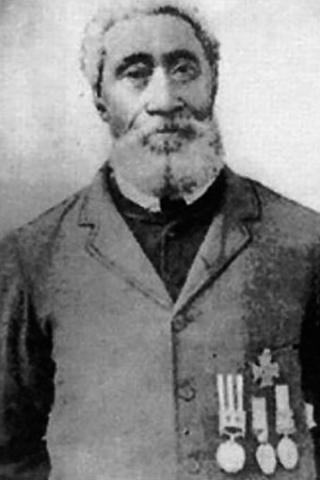
Early Life
William Neilson Edward Hall was born in Horton's Bluff, Nova Scotia, on April 28, 1827, the son of free Black slaves, rescued from slavery by a British frigate during the War of 1812.
Hall attended the local school, then worked in the shipyards of Hantsport for several years, involved in the construction of wooden ships for the merchant marine. Before he was even eighteen years old, he had already been to some of the most important ports in the world, having joined the crew of a trading vessel.
Joining the navy

William Hall’s Victoria Cross. Image courtesy of the Nova Scotia Museum.
In 1852, he left a promising career in the American merchant navy to enlist in the British Royal Navy. He served as Able Seaman onboard HMS Rodney during the Crimean War, and was awarded the Turkish Crimea medal, as well as the British Crimea medal with the "Sevastopol" and "Inkerman" clasps. He was a member of the Naval Brigade, and assisted the ground forces by manning heavy guns.
Heroics in India
Before the Indian Mutiny of 1857-58, he was appointed to "Captain of the Foretop" on board HMS Shannon. As the ship was on its way to China, in anticipation of a Chinese insurrection, it received orders to turn around and head to Calcutta (now Kolkata), India.
Hall and a brigade of soldiers were to head for Lucknow, to relieve the British garrison which was under siege.
Hall was a member of one of four gun crews. He and his colleagues were attempting to breach the walls of the Shah Najaf mosque as rebels shot at them. The enemy concentrated its fire on the gun crews until Hall and an officer, Lieutenant James Young, were the only ones left. They continued to load and fire the last gun until the wall was breached, giving the soldiers of the British garrison enough room to scramble through.
“Lieutenant (now Commander) Young, late Gunnery Officer of Her Majesty's ship 'Shannon,' and William Hall, 'Captain of the Foretop,' of that Vessel, were recommended by the late Captain Peel for the Victoria Cross, for their gallant conduct at a 24-Pounder Gun, brought up to the angle of the Shah Nujjiff, at Lucknow, on the 16th of November, 1857.”
Petty Officer William Hall was the first Nova Scotian (the third Canadian), and the first Black person in the British empire, to receive the Victoria Cross.
Life after service
He retired from the service in 1876 with the rank of Petty Officer, First Class. He moved back to Nova Scotia and lived with his sisters on a farm in Avonport, overlooking the Minas Basin.
Hall lived in relative obscurity until 1901, when His Royal Highness, the Duke of Cornwall and York, the future King George V, visited Nova Scotia to unveil a monument. A parade was held in his honour, and Hall was in attendance, with his Victoria Cross and other service medals pinned to his chest. The Duke noticed this and enquired about the medals, opening a conversation between the two men.
William Neilson Edward Hall died in Hantsport on August 25, 1904, of paralysis. He was buried in an unmarked grave in Lockhart, without military honours.
Remembering William Hall

In February, 2010, Canada Post issued a commemorative stamp to honour William Hall.
In 1937, a campaign was launched to have William Hall recognized by the Royal Canadian Legion, and it was not until 1954 that his remains were reinterred in the grounds of the Hantsport Baptist Church. A cairn was erected in his honour two years later by the Hantsport Branch of the Legion, which includes an enlarged bronze replica of his Victoria Cross and a plaque describing his actions and devotion to duty.
Hall's Victoria Cross
In 1967, Hall's medals were returned to Canada from England to be shown at Expo '67, in Montreal. For a number of years, his Victoria Cross and other medals were lent to the Canadian War Museum in Ottawa. Today, his medals are on display at the Nova Scotia Museum in Halifax.
Hall's Victoria Cross was worn on a blue ribbon, to represent the Royal Navy, as it was awarded with such a ribbon colour since its inception in 1856, whereas the Victoria Cross with crimson ribbon was awarded to members of the armed forces. Since 1918, however, all Victoria Crosses are worn on the crimson ribbon.